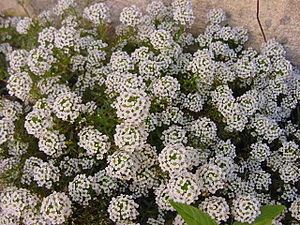
[amazon_link asins=’B0714P8DB3,B004YE8DMU,B01FPPVFZ8,B005MLLJQQ,B078VLGN85,B00DWY21KS,B005MLJPRG,B00M645ITG,B008GO5A8Y’ template=’ProductCarousel’ store=’finmeacur-20′ marketplace=’US’ link_id=’6c990f01-10c2-11e8-81bb-97e0926eec3a’]
Botanical Name: Lobularia maritima
Family : Cruciferae
Genus : Lobularia
Synonyms : Alyssum maritimum – (L.)Lam., Clypeola maritima – L.
Common Name: Sweet alyssum
Habitat : Europe – Mediterranean. Naturalized in Britain. Dry sunny places in the Mediterranean. Grows by the coast in Britain. Cultivated Beds; South Wall In; West Wall In;
Description:
Annual/Perennial growing to 0.15m by 0.25m at a fast rate.
It is hardy to zone 7. It is in leaf from April to October, in flower from June to October,Flower Color: Purple, red, white and the seeds ripen from July to October. The flowers are hermaphrodite (have both male and female organs) and are pollinated by Insects. The plant is not self-fertile. It is noted for attracting wildlife.
The plant prefers light (sandy), medium (loamy) and heavy (clay) soils and requires well-drained soil. The plant prefers acid, neutral and basic (alkaline) soils. It cannot grow in the shade. It requires dry or moist soil. The plant can tolerate maritime exposure.
Cultivation :
Succeeds in an ordinary garden soil in a sunny position. Succeeds in sandy soils. Grows well on dry walls. Tolerates maritime conditions. Although a short-lived perennial, it soon loses its compact habit if grown for more than one year and so is usually grown as an annual plant in gardens. A very ornamental plant, there are several named forms developed for their ornamental value. This species usually self-sows in the garden if growing in a good position. A fast-growing plant, it makes a good edging to a plant bed. The forms of this species with white flowers have the refreshing scent of new-mown hay – flowers of other colours having little or no scent. A good bee and butterfly plant.
Propagation:
Seed – it can be sown in situ during mid to late spring and should germinate within 2 weeks[200]. Seedlings can be transplanted. In order to obtain an earlier display of the flowers, the seed can be sown in a greenhouse in late winter. When large enough to handle, the seedlings are pricked out into individual pots and are then planted out in late spring.
Edible Uses
Edible Uses: Condiment.
The young leaves, stems and flowers are sometimes used as a flavouring in salads and other dishes where pungency is required.
Medicinal Actions & Uses:
Antiscorbutic; Astringent; Diuretic.
The plant is commonly used in Spain as an antiscorbutic and diuretic . It is also highly esteemed there as an astringent in the treatment of gonorrhoea.
Scented Plants
Flowers: Fresh
The forms of this species with white flowers have the refreshing scent of new-mown hay.
Disclaimer:The information presented herein is intended for educational purposes only. Individual results may vary, and before using any supplements, it is always advisable to consult with your own health care provider.
Resources:
http://www.pfaf.org/database/plants.php?Lobularia+maritima
http://www.ces.ncsu.edu/depts/hort/consumer/factsheets/annuals/lobularia_maritima.html
http://www.desert-tropicals.com/Plants/Brassicaceae/Lobularia_maritima.html





















![Reblog this post [with Zemanta]](https://i0.wp.com/img.zemanta.com/reblog_e.png?w=580)



















